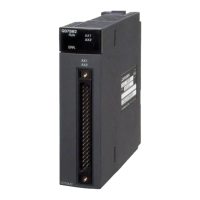5
REDUNDANT SYSTEM FUNCTIONS
5.1 Basic Concept of Redundant System
5.1.1 Determination of System A/System B
5 - 4
1
OVERVIEW
2
SYSTEM
CONFIGURATION
3
TRACKING CABLE
4
PROCEDURE FOR
STARTING UP A
REDUNDANT SYSTEM
5
REDUNDANT SYSTEM
FUNCTIONS
6
REDUNDANT SYSTEM
NETWORKS
7
PROGRAMMING
CAUTIONS
8
TROUBLESHOOTING
(2) Confirming system A/System B
*1
Identify system A and system B by checking the "SYSTEM A" and "SYSTEM B" LEDs
of CPU modules.
Refer to the following manual, for details on the CPU module LED.
QCPU User's Manual (Hardware Design, Maintenance and Inspection)
* 1: System A and System B can be identified by checking whether the special relays "System A
discriminating flag (SM1511)" and "System B discriminating flag (SM1512)" are ON or OFF.
(3) Precautions
When using the redundant system in the backup mode, connect the tracking cable to
the control system and the standby system CPU modules.
If both systems are powered on without the tracking cable connected to the CPU
models, the "TRK.CABLE ERR. (error code: 6120)" stop error will occur and the
system cannot run.
If "TRK. CABLE ERR." occurs at power-on, power off System A and System B, then
connect the tracking cable to the CPU modules, and power the systems on again.
POINT
When starting up a single basic system, use the debug mode.
Refer to Section 5.1.3, for the debug mode.
Table5.1 Identify system A and system B by checking the "SYSTEM A" and "SYSTEM B" LEDs
CPU Module LED LED Statuses
LED Name System A System B
SYSTEM A ON OFF
SYSTEM B OFF ON
Table5.2 Confirming SM1511 and SM1512 to Identify
System A and System B
SM1511 SM1512
System A ON OFF
System B OFF ON
Q12PRHCPU
MODE
RUN
ERR.
USER
BAT.
BOOT
BACKUP
CONTROL
SYSTEM A
SYSTEM B

